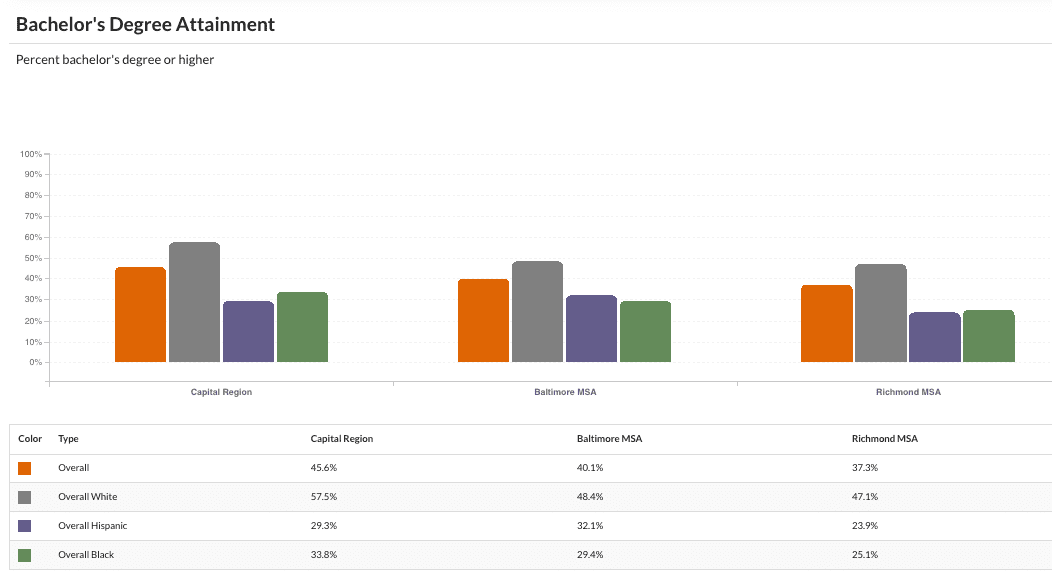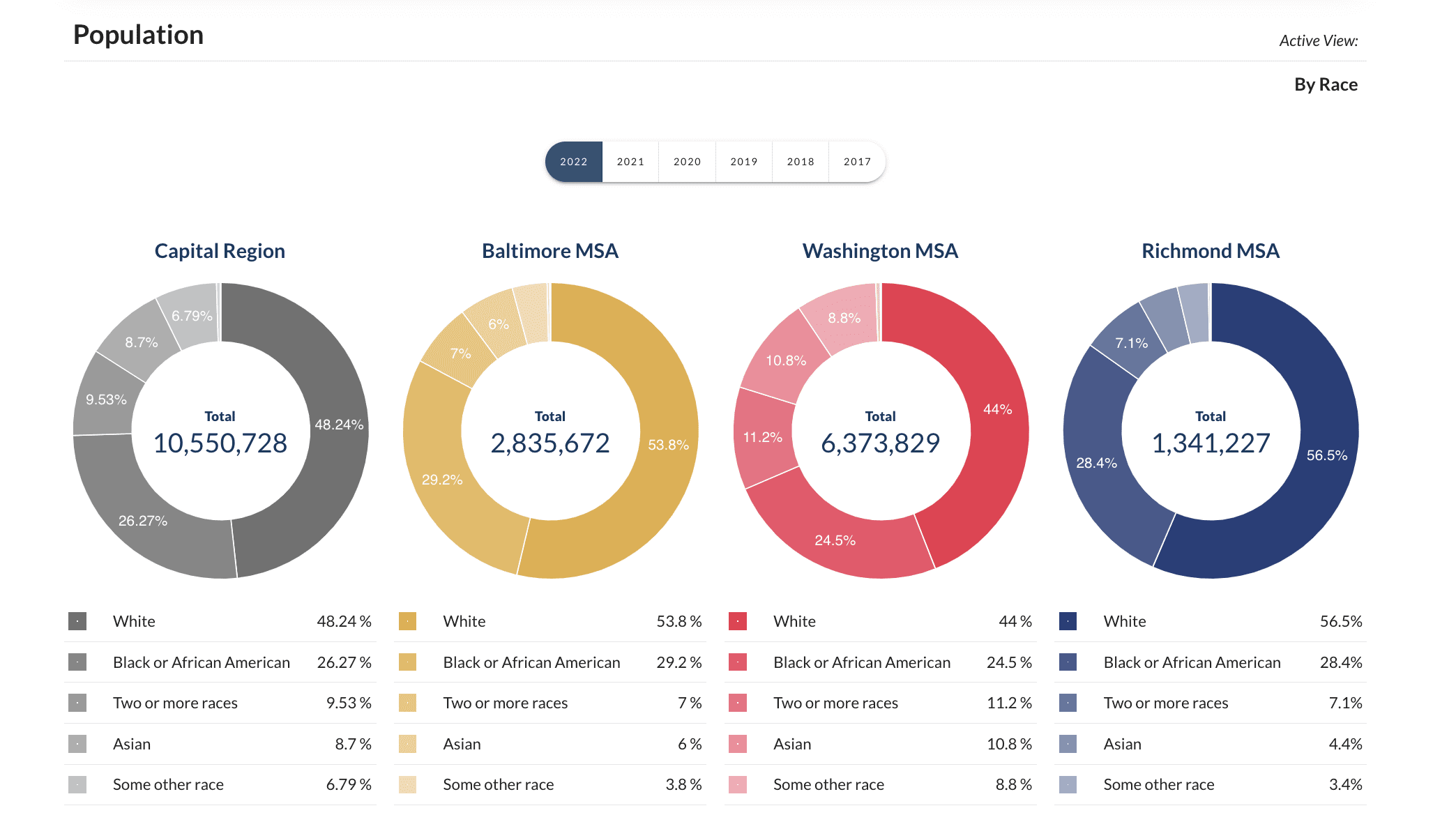The Partnership recently released data updates within its Inclusive Growth Dashboard, an interactive tool that features more than 40 indicators tracking the region’s economic and demographic trends. The Dashboard is a one-stop resource for cross-sector leaders interested in inclusive economic growth and can inform policies, programs, and investments that drive equitable outcomes for all the region’s residents – regardless of race, gender, or zip code.
Specifically, the Dashboard measures the region’s progress on six “pillars” or categories of information tied to the Partnership’s Regional Blueprint for Inclusive Growth, a 10-year roadmap to drive economic competitiveness and close the region’s equity gaps that was first released in 2022. The data provides awareness of the region’s overall economic health and intra-regional progress against important equity metrics.
 Inspired by the Partnership’s Regional Blueprint for Inclusive Growth, a 10-year roadmap to drive economic competitiveness and close the region’s equity gaps released in 2022, the Dashboard aims to measure the region’s progress under six major pillars—education, health equity, infrastructure, workforce, access to capital and affordable housing—and highlight areas of opportunity for cross-sector stakeholders to intensify investments where most needed.
Inspired by the Partnership’s Regional Blueprint for Inclusive Growth, a 10-year roadmap to drive economic competitiveness and close the region’s equity gaps released in 2022, the Dashboard aims to measure the region’s progress under six major pillars—education, health equity, infrastructure, workforce, access to capital and affordable housing—and highlight areas of opportunity for cross-sector stakeholders to intensify investments where most needed.
The Dashboard offers unique functionality, as it:
- Provides data specific to the Baltimore, Richmond and Washington, D.C. metropolitan statistical areas (MSAs), as well as aggregate regional data;
- Presents demographic nuances within the data, such as racial and gender disaggregation (when available) and specific callouts of disparity gaps; and
- Shows trends over time through different display options, updated annually with the latest available data.
 |
|
These images are examples of the data visualization within the Dashboard, illustrating data across all three MSAs broken down by race and ethnicity at either a point in time or as trendlines across multiple years.
A few key insights from the latest Dashboard update:
- Lack of housing construction – both affordable and market rate – is driving many of our region’s challenges to inclusive growth. Housing production is decreasing at a time when it needs to be growing significantly: the region built 10,815 fewer housing units in 2023 compared to 2022, despite continued demand. This not only drives up housing costs for all our region’s residents but also contributes to net domestic migration out of the region, often to places with a lower cost of living. From 2022 to 2023, net domestic moves away from the region resulted in a loss of 39,000 residents. Overall population growth remained slightly positive due to international migrant arrivals and modest natural increases (births exceeding deaths).
- Racial disparities remain entrenched across the region, particularly when it comes to educational attainment and earnings. The Black-white disparity gap in bachelor’s degree attainment stands at 22.3 percentage points—a gap that has only narrowed slightly since 2015— highlighting the ongoing work needed to ensure equitable access to higher education, good jobs, and economic opportunity for all our region’s residents. Troublingly, the share of Black students enrolled full-time in undergraduate and postgraduate programs declined between 2016 and 2022 across DC, Maryland, and Virginia. Even as the region’s median household income has steadily increased in recent years, the Black-white gap in median household income has widened in Baltimore (up from $43K to $47K) and Richmond (up from $35K to $37K), while decreasing slightly in DC (down to $47K from $51K in 2021).
- The region boasts a highly educated workforce – with rates highest among women. With nearly 47% of adults holding at least a bachelor’s degree, the region is among the most highly educated in the country. The region also stands out for having a particularly high female bachelor’s degree attainment at 47.6%. This leads to higher incomes, and higher labor force participation rates, making our region especially competitive on the talent front.
- In 2023, the region surpassed its pre-pandemic total employment level, but the recovery has been uneven across metro areas. The total number of jobs across the three metro areas totaled 4.89 million in 2023, pushing the region above its 2019 level for the first time since the pandemic. Growth has been strongest in the Richmond area, which now has 25,600 more jobs than in 2019. The Baltimore MSA, by contrast, still trails its pre-pandemic employment total by 15,000 jobs.
- Childcare costs are an increasing burden on working parents. Childcare expenses place a significant strain on working families with young children throughout the region, posing challenges for returning to in-person work, particularly for women. These concerns are particularly acute in Baltimore City, where average childcare costs for a household with two children are 39% of median household income. In Richmond, that share reaches 30%, while Washington, D.C., has the lowest among the three major cities at 27%, in part reflecting the city’s relatively higher median household income.
- Significant gaps in health insurance coverage persist for the region’s Hispanic residents. About one in five (21%) Hispanic residents in the region are uninsured, putting them at risk of poor health outcomes. The uninsured are less likely to receive preventative care or services for major health conditions and can quickly become saddled with large amounts of medical debt. This compares to just 3.3% of white residents, and 5.8% of Black residents.
The Partnership’s Inclusive Growth Board Committee provides indispensable insight and service as champions of this work. The Inclusive Growth Dashboard is made possible by the Committee’s unwavering support and dedication.
To learn more about the Dashboard’s methodology, click here.
The Blueprint and Dashboard are tools produced by the Partnership’s Inclusive Economic Growth initiative, which works with business, government, academic, and nonprofit leaders to build programs and investments across the region promoting equity and strengthening regional economic competitiveness.

